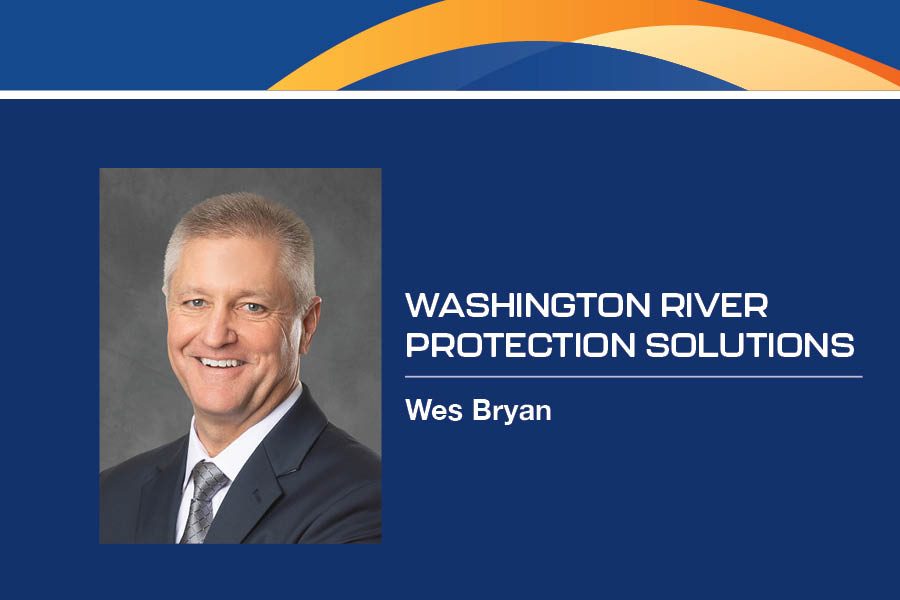
Home » WRPS plays key role as Hanford shifts back into production mode
Hanford 2024
WRPS plays key role as Hanford shifts back into production mode

April 15, 2024
By Wes Bryan
We are at a pivotal time in the history of the Hanford site’s noble mission.
Created in 1943 as part of the Manhattan Project, about 60% of the nation’s plutonium was produced on this site for the nation’s defense program. Today, waste management and environmental cleanup, including protection of the Columbia River, are Hanford’s primary missions. For the first time in Hanford’s history, the One Hanford team is treating radioactive and chemical tank waste, currently stored in hundreds of underground tanks, on an industrial scale and preparing to reduce that volume through vitrification and disposal. This is a victory for the nation, region, community and certainly our employees.
Washington River Protection Solutions (WRPS) plays an integral part in this; our team of 2,600 employees and subcontractors is responsible for treating the tank waste for immobilization through vitrification and operating several supporting process facilities. It’s an honor to serve the dedicated members of this team.
Building on our progress from 2023, 2024 is going to be a challenging and fulfilling year. We ended last year treating more than 840,000 gallons of tank waste; this year we will prepare to transfer it to Hanford’s Waste Treatment and Immobilization Plant (WTP) for vitrification.
We are on the verge of restarting Hanford’s Effluent Treatment Facility. The facility is critical to the Hanford tank waste vitrification mission, and over the last five years, the U.S. Department of Energy has invested in upgrades to increase capacity, capability, reliability and efficiency. Right now, we are going through operational testing and readiness activities to make sure the people, plant, and processes are ready.

A welder at Hanford’s Effluent Treatment Facility works on components of anew system that will be used to treat liquid waste resulting from vitrification, orthe immobilization of tank waste in glass.
| Courtesy Washington River Protection SolutionsSimilar activities are underway to prepare Hanford’s 242-A Evaporator to restart operations after numerous upgrades and repairs. By removing water from tank waste, this facility increases the amount of storage space in our newer double-shell tanks for continued safe storage until the waste is treated and immobilized, allowing those double-shell tank systems to receive more waste from older, single-shell tanks.
Tank-waste retrievals
And our tank-waste retrievals team is making great progress.
Once completion is certified, Tank AX-101 will be the site’s 21st single-shell tank to be retrieved, and AX Tank Farm will be the second tank farm at Hanford where waste retrieval operations have been completed. There are 18 tank farms (two fully retrieved) spread across the Hanford site, each holding large groups of underground waste storage tanks. We anticipate beginning retrieval of the next tank farm, A Tank Farm, this year.
We also are preparing for future tank waste retrieval and treatment activities across the site, installing infrastructure in the 200 West Area and planning additional facilities near WTP to provide more tank waste treatment and feed capacity for vitrification.
As the Hanford site mission has changed over the past 80 years, so too has ours. We are transitioning back to production on the site. But instead of plutonium we are producing vitrified tank waste from the hazardous waste left over from that plutonium production. While we have a number of challenging field activities underway, we also are preparing our people and processes for the increased pace of operations required to safely support the 24/7 feed of tank waste to WTP for vitrification.
This is a process we are going through at WRPS and one that is also taking place across the site, as the contractors and our Department of Energy customer increase collaboration and coordination to improve operations, performance and partnerships to enable an integrated waste treatment, feed and stabilization mission.
The Hanford site’s changing operational status isn’t possible without the steadfast support of our community, stakeholders and cleanup partners, including our talented subcontractors who bring creative solutions to the extremely challenging cleanup problems we face today.
We’re also looking ahead by ensuring we have the workforce ready to continue our progress on the site and for the clean energy future for which the Tri-Cities is already well-positioned. I appreciate our educational and community partners preparing bright students who have the possibility of joining us as interns, co-ops and employees, advancing our tank waste mission before helping our community and region transition to a clean energy economy.
I remind our team that we have a lot on our plates, and we have plenty of challenges ahead of us. But it’s important to remember the correct perspective: Every day we advance a noble mission that is important to our community, nation and world. It’s tremendously challenging but also tremendously rewarding, as we finish strong and prepare for the future.
Wes Bryan is president and project manager of Washington River Protection Solutions.
Latest News Hanford
KEYWORDS April 2024
Related Articles





